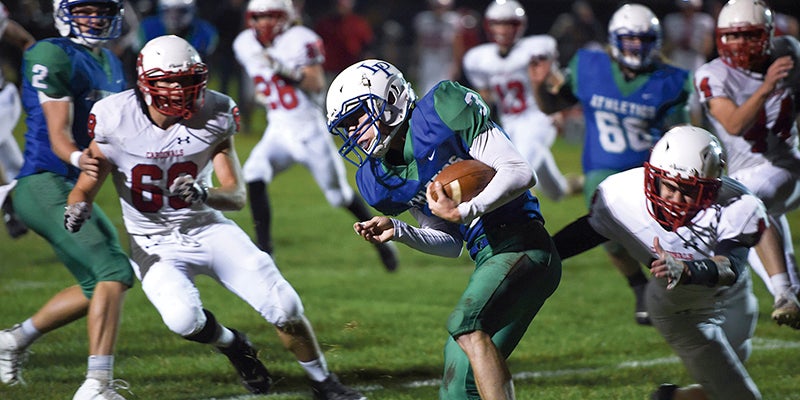Riege: Trollin Hard Water Walleyes
Published 9:07 pm Wednesday, November 21, 2012
With the beginning of the Ice Shows and the cooling of the weather, we know that it doesn’t seem possible that we are experiencing some frozen lakes. The ice season is about to start and hopefully you can prepare for some of those hard water walleyes.
Last year we had the opportunity to fish with Leisure Outdoor Adventures (www.leisureoutdooradventures.com) and many members of the Ice Team (www.iceteam.com.) at Ice Shots 2012 on Leech Lake. We learned some very valuable lessons especially about trolling for hard water walleyes.
Walleyes are without a doubt the most sought after game fish in the Midwest in the summer. Now’s a good time too. Walleyes are often considered to be schoolers, but under the ice they seem to disperse into loose associations. Pinpointing them is often difficult, but catching one is like finding a piece of the puzzle.
Show me a lake with an hourglass figure and a few good walleyes, and I’ll show you fish. The key is in the narrows of the lake. Perhaps it’s the current, or maybe the bottlenecking effect. Needless to say the narrows are a walleye attractor second to none. Points with a good extension into deep water are a close second. Bays nearby are also worth plying.
With three distinct target areas to choose from. I like to pick a lake with a narrows, a major point extending out into the main body and adjoining bays sandwiched in between. It doesn’t matter what the target species is, a combination of these structural elements is going to attract some fish during ice up.
I am not one of those ice fisherman that will sit and sit waiting for a bite, in fact, one might say that I am really aggressive when it comes to ice fishing. Oh, it is true that fish are sluggish in the winter and you often need to tease them into hitting. Perch, walleye, northern pike, bluegill, crappie, and trout are attracted to movement. They respond to it automatically. (That is one of the reason that we have portable ice shelters like the ones Clam makes.) In the warm months, trollers and casters tend to catch more than stillfisherman. In the winter, about the only movement you can create is a vertical hop or jig, but that is better than letting your bait hang there like so much wet laundry.
Panfisherman especially like to wiggle those tiny ice flies and teardrops tipped with grubs or waxworms. Originally, most panfishing was done with light lines and small bobbers. Anglers bounced the bobber up and down on the water, then waited for the fish to bite. Many of these fisherman could tell you that they often times they have been bit and couldn’t of detected even the slightest nibble.
Always adjust your ice fishing presentation to the fish. For instance if you have all the right conditions for a good bite (fish showing on the sonar, stable weather, and rumors that fish are biting) use a technique that will work on aggressive fish.
Crappie minnows fished near the bottom provide some of the finest mid-winter perch fishing to be found anywhere. On good days, fish from 11 to 13 inches can be caught two at a time, as fast as the angler can get rebaited and back to the bottom.
The typical “perch rig” two #6 snelled hooks attached to the line 8 and 16 inches above a 1/2 ounce bell sinker, works well. Some anglers use tiny spinner blades and beads on their hooks to serve as additional attractors. Hooking a crappie minnow either through the lips or behind the dorsal fin works equally as well. The perch aren’t fussy sometimes striking bare hooks. Light spinning tackle and #4 test Northland Bionic Ice line completes the tackle required to catch these delicious denizens.
Your lure selection might also have to change. Right now on many lakes glow/blue Moxie minnows are hot. If that color isn’t productive move on to other colors. The style and shape of the Moxie minnow allows it to flutter as it falls. This will simulate a wounded minnow and turn those inactive fish into active ones.
Another type of lure that suspends the rate of fall is the Salmo Chubby Darter. These types of lures have a swimming action and they dart as they fall. This will give the fish an impression that minnows are darting and swimming towards them and escaping from them and it will trigger a response from those finicky walleyes.
Remember to be conscience of the size of your bait. The old adage that the “larger the bait, the larger the fish,” will hold true, but if the fish turn off, try a smaller size and you might be surprised.
Of course at this time of year it is hard to troll to find active fish, but in a sense you can apply the methods that you use in the summertime. Drill holes from the shallowest portion of the structure you are fishing and then continue to drill holes at various depths as the structure drops off into deeper water. Then instead of “trolling” along the structure you can use tip-ups to cover from the deepest to the shallowest point. Tip-ups enable you to cover more water than you could with a minnow and float. A flag can be seen from several hundred feet away. Most states allow you to use two lines and if you have a number of fishing buddies with you, you can cover the structure at various depths and in effect troll the edge of the structure.





